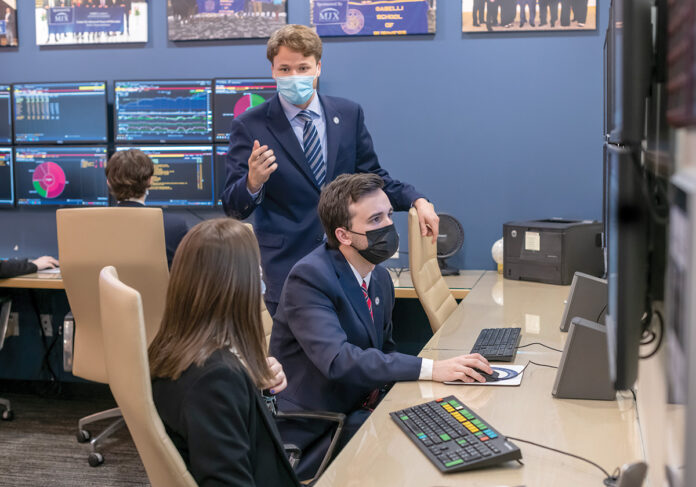Eric Baxter and Lauren Ryan recently spent an all-nighter in the Roger Williams University student investment room, where they anxiously pondered what shares they wanted to trade on the global stock market.
Their eyes were glued to the room’s flatscreens monitoring updates on the global stock exchanges. Throughout the night and into the morning, the two RWU juniors scanned the numbers. At stake: the health of RWU’s student-run investment fund.
“It’s definitely like a job,” Baxter said. “There’s a lot of adrenaline when we’re making trades throughout the day in the room. It’s definitely a rollercoaster ride, to say the least.”
The program, the Center for Advanced Financial Education, known as CAFE, is a two-semester credit-based program taught in a Wall Street simulator, equipped with the latest technology and equipment.
For students in CAFE, they gain experiential knowledge of the high-risk world of global investing in preparation for a career in the financial sector. And it’s not a theoretical simulator. The pressure for the students to deliver is real, as hundreds of thousands of dollars in a student-run fund are on the line.
More than 500 colleges and universities have student-run investment funds, some as small as a few thousand dollars to as large as tens of millions of dollars, according to the Center for Investment Research.
Some investment funds are seeded by gifts from alumni, while others come from foundations or corporations.
The University of Rhode Island’s student investment fund began with a $100,000 donation made by the URI Alumni Association in 2001 and has grown to a market value of more than $800,000 in 20 years.
At Bryant University, the school’s finance students manage over $2 million in its Archway Investment Fund, an equity and fixed income fund.
‘There’s a lot of adrenaline when we’re making trades.’
ERIC BAXTER, Roger Williams University student
Roger Williams University wouldn’t make public the amount in its student fund. Michael “Doc” Melton, an RWU finance professor and founding director of CAFE, said fund performance isn’t as important as experiential learning.
“Zeroes don’t matter,” he said. “What matters is the student’s experience, the training, and the real-world hours they are getting.”
Melton created the CAFE Portfolio Management Program after being hired by the school in 2004. It was designed to “replicate investment firm analyst pods” and is updated using feedback from industry alumni.
Michelle Lord, executive director of the Financial Management Association at the University of South Florida, Muma College of Business, says the experience of participating in student-run funds is invaluable when students move into the financial world, and employers recognize that value.
“You need time to figure out the skills in handling these funds,” she said. “And I have seen students do really well with their job placement.”
URI students make connections with industry professionals, some of which are alumni, said Michael Ice, who co-teaches the Ram Fund’s three-credit elective course.
In 2020, the Ram Fund ranked first by Quinnipiac GAME Forum for its 52% return that year, besting over 150 student-managed global funds.
“This is much more than a traditional class,” said Ice, noting that grades are not determined by testing. “Students have to make the grade every day, just like in the real world.”
Well, not exactly like the real world. At Bryant, students pitch ideas to their instructors, and they must follow certain rules when managing the fund, says Asli Ascioglu, a Bryant finance professor. But ultimately, it’s the decision of the students about what stocks to buy, even if an investment appears to be risky.
Kevin J. Maloney, a Bryant finance professor, says when his students pitched buying stock in electric vehicle manufacturer Tesla Inc. last fall, he was not in favor of it since it is not a typical car manufacturer. “I said we should value it like a tech company,” he said.
Eventually, students decided it was overvalued and didn’t buy. They might wish that they had. Telsa has grown to become one of the top companies on the Standard & Poor’s 500 index.
Maloney says the students learned how to overcome adversity when the fund went through a 25% market downturn at the outset of the pandemic in the spring of 2020.
At Roger Williams, the CAFE program calls for the students to spend more than 40 hours a week in the investment room managing funds as part of their course studies. Baxter said students act as fund managers, equity analysts and project managers.
“I would say that I am in the room at least 44 hours a week,” he said, noting that students spend a minimum of 18 hours per week in the CAFE.
Ryan says her roommate, a marine biology major, does not understand the time commitment for the program. “She thinks we’re crazy,” said Ryan, who noted that the experience is invaluable.
“I like always being challenged, which is why I wanted to go into this program,” she said. “It definitely challenges you.”
Cassius Shuman is a PBN staff writer. Email him at Shuman@PBN.com.











